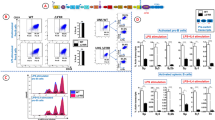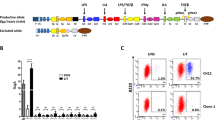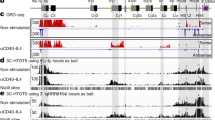Abstract
The switch of the immunoglobulin isotype from IgM to IgG, IgE or IgA is mediated by class switch recombination (CSR). CSR changes the immunoglobulin heavy chain constant region (CH) gene from Cμ to one of the other CH genes1,2. Somatic hypermutation introduces massive numbers of point mutations in the immunoglobulin variable (V) region gene, giving rise to immunoglobulin with higher affinity3. Activation-induced cytidine deaminase (AID), a putative RNA-editing cytidine deaminase, is expressed strictly in activated B cells and is indispensable in both CSR and somatic hypermutation4,5. But the exact function of AID is unknown. Here we show that ectopic expression of AID induces CSR in an artificial switch construct in fibroblasts at a level comparable to that in stimulated B cells. Sequences around recombination junctions in the artificial substrate have features similar to endogenous CSR junctions. Furthermore, AID-induced CSR in fibroblasts is dependent on transcription of the target S region, as shown in endogenous CSR in B cells. The results show that AID is the only B-cell-specific factor required for initiation of the CSR reaction in the activated locus.
This is a preview of subscription content, access via your institution
Access options
Subscribe to this journal
Receive 51 print issues and online access
$199.00 per year
only $3.90 per issue
Buy this article
- Purchase on Springer Link
- Instant access to full article PDF
Prices may be subject to local taxes which are calculated during checkout




Similar content being viewed by others
References
Honjo, T., Kinoshita, K. & Muramatsu, M. Molecular mechanism of class switch recombination: linkage with somatic hypermutation. Annu. Rev. Immunol. 20, 165–196 (2002); published online 4 October 2001 (DOI 10.1146/annurev.immunol.20.081701.141316v4)
Kinoshita, K. & Honjo, T. Linking class-switch recombination with somatic hypermutation. Nature Rev. Mol. Cell Biol. 2, 493–503 (2001)
Neuberger, M. S. & Milstein, C. Somatic hypermutation. Curr. Opin. Immunol. 7, 248–254 (1995)
Muramatsu, M. et al. Class switch recombination and hypermutation require activation-induced cytidine deaminase (AID), a potential RNA editing enzyme. Cell 102, 553–563 (2000)
Revy, P. et al. Activation-induced cytidine deaminase (AID) deficiency causes the autosomal recessive form of the Hyper-IgM syndrome (HIGM2). Cell 102, 565–575 (2000)
Stavnezer, N. J. & Sirlin, S. Specificity of immunoglobulin heavy chain switch correlates with activity of germline heavy chain genes prior to switching. EMBO J. 5, 95–102 (1986)
Yancopoulos, G. D. et al. Secondary genomic rearrangement events in pre-B cells: VHDJH replacement by a LINE-1 sequence and directed class switching. EMBO J. 5, 3259–3266 (1986)
Lee, C. G. et al. Quantitative regulation of class switch recombination by switch region transcription. J. Exp. Med. 194, 365–374 (2001)
Rolink, A., Melchers, F. & Andersson, J. The SCID but not the RAG-2 gene product is required for Sμ-Sɛ heavy chain class switching. Immunity 5, 319–330 (1996)
Casellas, R. et al. Ku80 is required for immunoglobulin isotype switching. EMBO J. 17, 2404–2411 (1998)
Manis, J. P. et al. Ku70 is required for late B cell development and immunoglobulin heavy chain class switching. J. Exp. Med. 187, 2081–2089 (1998)
Muramatsu, M. et al. Specific expression of activation-induced cytidine deaminase (AID), a novel member of the RNA-editing deaminase family in germinal center B cells. J. Biol. Chem. 274, 18470–18476 (1999)
Petersen, S. et al. AID is required to initiate Nbs1/γ-H2AX focus formation and mutations at sites of class switching. Nature 414, 660–665 (2001)
Nakamura, M. et al. High frequency class switching of an IgM+ B lymphoma clone CH12F3 to IgA+ cells. Int. Immunol. 8, 193–201 (1996)
Kinoshita, K., Tashiro, J., Tomita, S., Lee, C. G. & Honjo, T. Target specificity of immunoglobulin class switch recombination is not determined by nucleotide sequences of S regions. Immunity 9, 849–858 (1998)
Tashiro, J., Kinoshita, K. & Honjo, T. Palindromic but not G-rich sequences are targets of class switch recombination. Int. Immunol. 13, 495–505 (2001)
Chen, X., Kinoshita, K. & Honjo, T. Variable deletion and duplication at recombination junction ends: Implication for staggered double-strand cleavage in class-switch recombination. Proc. Natl Acad. Sci. USA 98, 13860–13865 (2001)
Lupton, S. D., Brunton, L. L., Kalberg, V. A. & Overell, R. W. Dominant positive and negative selection using a hygromycin phosphotransferase–thymidine kinase fusion gene. Mol. Cell. Biol. 11, 3374–3378 (1991)
Kuzin, I. I. et al. Tetracyclines inhibit activated B cell function. Int. Immunol. 13, 921–931 (2001)
Fagarasan, S., Kinoshita, K., Muramatsu, M., Ikuta, K. & Honjo, T. In situ class switching and differentiation to IgA-producing cells in the gut lamina propria. Nature 413, 639–643 (2001)
Gu, H., Zou, Y. R. & Rajewsky, K. Independent control of immunoglobulin switch recombination at individual switch regions evidenced through Cre-loxP-mediated gene targeting. Cell 73, 1155–1164 (1993)
Jung, S., Rajewsky, K. & Radbruch, A. Shutdown of class switch recombination by deletion of a switch region control element. Science 259, 984–987 (1993)
Xu, L. et al. Replacement of germ-line e promoter by gene targeting alters control of immunoglobulin heavy chain class switching. Proc. Natl Acad. Sci. USA 90, 3705–3709 (1993)
Zhang, J., Bottaro, A., Li, S., Stewart, V. & Alt, F. W. A selective defect in IgG2b switching as a result of targeted mutation of the Iγ2b promoter and exon. EMBO J. 12, 3529–3537 (1993)
Dunnick, W., Hertz, G. Z., Scappino, L. & Gritzmacher, C. DNA sequences at immunoglobulin switch region recombination sites. Nucleic Acids Res. 21, 365–372 (1993)
Iwasato, T., Arakawa, H., Shimizu, A., Honjo, T. & Yamagishi, H. Biased distribution of recombination sites within S regions upon immunoglobulin class switch recombination induced by transforming growth factor β and lipopolysaccharide. J. Exp. Med. 175, 1539–1546 (1992)
Obata, M. et al. Structure of a rearranged γ 1 chain gene and its implication to immunoglobulin class-switch mechanism. Proc. Natl Acad. Sci. USA 78, 2437–2441 (1981)
Winter, E., Krawinkel, U. & Radbruch, A. Directed Ig class switch recombination in activated murine B cells. EMBO J. 6, 1663–1671 (1987)
Cubitt, A. B. et al. Understanding, improving and using green fluorescent proteins. Trends Biochem. Sci. 20, 448–455 (1995)
Kitamura, T. New experimental approaches in retrovirus-mediated expression screening. Int. J. Hematol. 67, 351–359 (1998)
Acknowledgements
We are grateful to H. Yagita and Targeted Genetics Co. for providing the HM40-3 monoclonal antibody and the tgCMV/HyTK plasmid, respectively. We thank Y. Sakakibara, K. Ikuta, H. Nagaoka, S. Fagarasan and T. Okazaki for their critical reading of the manuscript; T. Muto, T. Eto and T. Doi for discussions; Y. Tabuchi, T. Toyoshima and K. Yurimoto for their technical assistance; and T. Nishikawa for secretarial help. This work was supported by a Center of Excellence Grant from the Ministry of Education, Culture, Sports, Science and Technology of Japan. I.O. is a research fellow of the Japan Society for the Promotion of Science.
Author information
Authors and Affiliations
Corresponding author
Ethics declarations
Competing interests
The authors declare that they have no competing financial interests
Rights and permissions
About this article
Cite this article
Okazaki, Im., Kinoshita, K., Muramatsu, M. et al. The AID enzyme induces class switch recombination in fibroblasts. Nature 416, 340–345 (2002). https://doi.org/10.1038/nature727
Received:
Accepted:
Published:
Issue Date:
DOI: https://doi.org/10.1038/nature727
This article is cited by
-
B cell-specific knockout of AID protects against atherosclerosis
Scientific Reports (2023)
-
Diversity of Immunoglobulin (Ig) Isotypes and the Role of Activation-Induced Cytidine Deaminase (AID) in Fish
Molecular Biotechnology (2018)
-
Chromatin remodeller SMARCA4 recruits topoisomerase 1 and suppresses transcription-associated genomic instability
Nature Communications (2016)
-
Global gene regulation during activation of immunoglobulin class switching in human B cells
Scientific Reports (2016)
-
Induction of activation-induced cytidine deaminase by a not-directly mutagenic carcinogen: a novel potential molecular mechanism
Environmental Health and Preventive Medicine (2014)
Comments
By submitting a comment you agree to abide by our Terms and Community Guidelines. If you find something abusive or that does not comply with our terms or guidelines please flag it as inappropriate.



